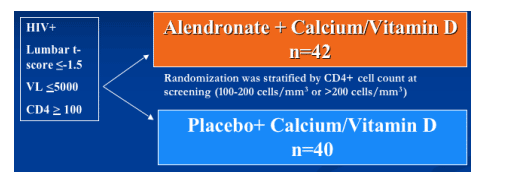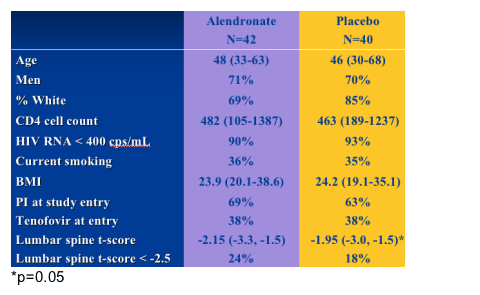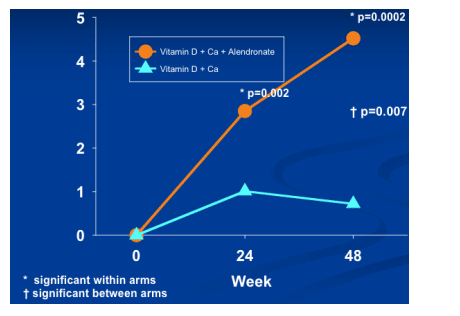 |
 |
 |
| |
Alendronate Modestly Improved BMD in 48 Week ACTG Study
|
| |
| |
A Phase II, Randomized, Placebo-Controlled Study of Once-Weekly Alendronate in HIV-Infected Subjects with Decreased Bone Mineral Density Receiving Calcium and Vitamin D
Reported by Jules Levin
CROI, Feb 2007, Los Angeles
Grace A McComsey reported these study results on behalf of the ACTG A5163 team.
AUTHOR SUMMARY:
Study Limitations:
-- Osteopenia may not require treatment
-- Duration relatively short: need longer term efficacy and tolerability
-- 21% changed ARV during study (5 TDF): results unchanged when these 5 subjects were excluded
-- Alendronate given with calcium/vitamin D led to significant increases in lumbar spine, total hip and trochanter BMD
-- Calcium/vitamin D alone led to modest increases in BMD
-- Alendronate was well tolerated, without significant adverse events
-- There was no evidence of treatment/sex interactions at any of the bone sites examined
Background
Decreased bone mineral density (BMD) is prevalent among persons living with HIV infection, as are traditional risk factors for reduced BMD.
Alendronate is a bisphosphonate that inhibits osteoclast-mediated bone resorption and is FDA-approved for the treatment of osteoporosis in men and women.
Small open-label studies of alendronate in combination with calcium and vitamin D in HIV+ individuals suggested the drug increases lumbar spine BMD and is well tolerated (Guaraldi 2004; Mondy 2005; Negredo 2005).
Study Design
A5163 is a 48-week prospective, randomized, double blinded, placebo-controlled trial to evaluate the effects of alendronate versus placebo, with calcium and vitamin D supplementation, on BMD in patients with HIV.
HIV+ patients with lumbar t-score 100 received either alendronate + calcium/Vit D (n=42) or placebo + calcium/Vit d (n=40).

Study regimen: 48 weeks
-- Alendronate or matching placebo 70 mg weekly
-- Calcium carbonate/Vitamin D (500 mg/200 IU BID)
INCLUSION/Exclusion Criteria
Inclusion
Documented HIV
≥ 25 years
CD4 ≥ 100 cells/mm3
HIV-1 RNA ≦ 5,000 cps/mL
Lumbar spine t-score ≦ -1.5
Stable ARV for ≥ 12 wks
No plan to alter ARV, exercise habits, or diet
Exclusion
Pregnancy or breast-feeding
Untreated hypogonadism or hyperthyroidism
25-OH vitamin D <15 ng /mL
Hepatitis C
PTH > 80 pg/mL
Chronic systemic steroids
Treatment for osteoporosis
Recent bone fracture
Esophageal pathology
Main Study Objectives
To examine the efficacy of once-weekly alendronate and daily calcium and vitamin D in the treatment of HIV-associated decreased BMD, as assessed by percent change in lumbar spine BMD from baseline to week 48 in men receiving alendronate versus placebo
To assess the safety and tolerability of once-weekly alendronate in HIV-infected subjects
To examine gender interactions in the efficacy of once-weekly alendronate and daily calcium and vitamin D in the treatment of HIV-associated decreased BMD
Statistical Considerations
Study powered (80% power; 2-sided alpha = 0.05) to detect an absolute difference of 3.5% in the mean percent change between arms in men. An additional 20% enrolled to account for possible drop-out and unevaluable DXA scans for a total of 27-30 men per arm .
To test for moderate treatment/sex interactions, 10-13 women per arm were also included (total n=80)
Baseline Characteristics
38% in each arm were taking tenofovir. Lumbar t-score -2.15 in alendronate arm, -1.95 in placebo (p=0.05). Lumbar t-score < -2.5: 24% in alendronate arm, 18% in placebo arm.



Two traumatic fractures occurred during the study (one per arm).
No evidence of a treatment/sex interaction when we considered the % change from baseline to week 48 in BMD assessed at the lumbar spine, total hip, or trochanter (p=0.41, 0.82, and 0.19, respectively).
Changes from 0 to 24 weeks strongly predicted changes from 0 to 48 weeks
In a multivariable model correcting for treatment, BMI and baseline L-spine BMD, black race was associated with a smaller % change from baseline in lumbar spine BMD with alendronate (p=0.003).
Safety/Tolerability
More signs/symptoms of Grade ≥ 3 in the placebo arm (15% versus 0% in the alendronate arm; p=0.01)
No difference between treatment arms in Grade ≥ 3 laboratory toxicities (15% on placebo arm versus 17% on alendronate; p>0.9)
No discontinuation related to toxicity
|
| |
|
 |
 |
|
|